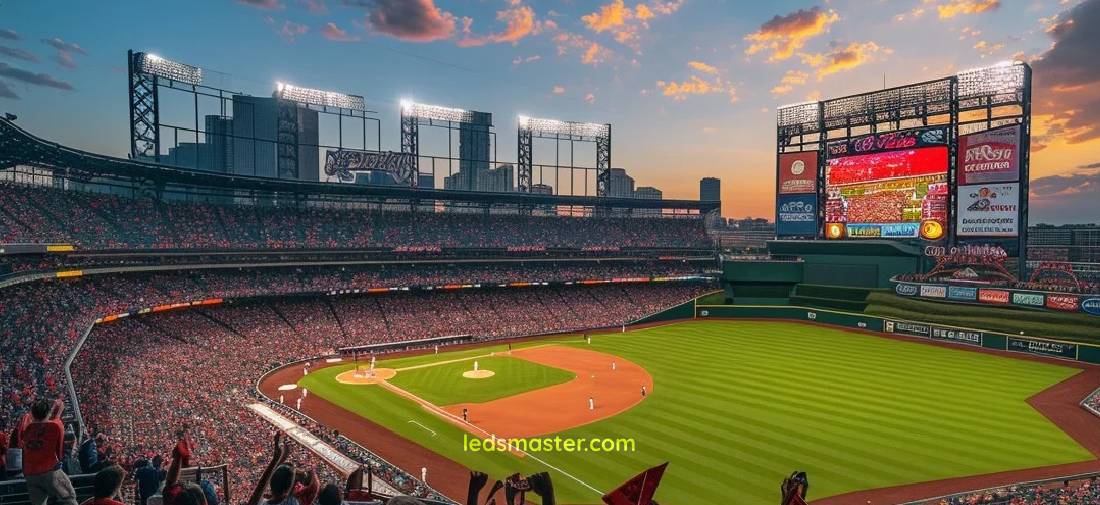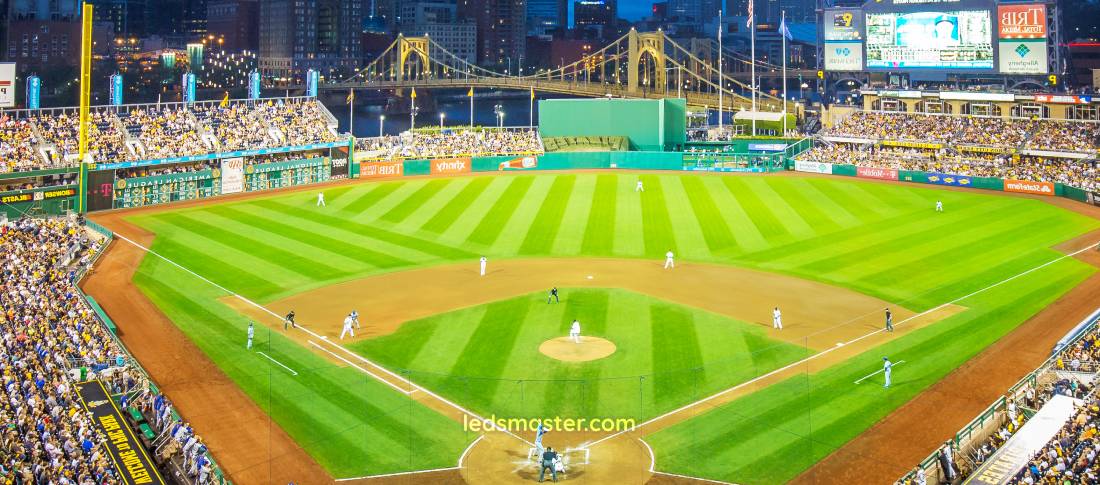Choosing the perfect lighting hue isn’t just about visibility—it’s about creating an atmosphere that enhances every swing, catch, and cheer. Discover how selecting the ideal color temperature can elevate both playability and ambiance, making every game under the lights a memorable event
Get your complimentary lighting design today
From Little League diamonds to Major League stadiums, the art and science of baseball field lighting have evolved to enhance every aspect of the game. Central to this evolution is the careful consideration of color temperature—a critical factor that influences visibility, player performance, and overall spectator experience under the lights.
Table of Contents
ToggleWhen illuminating baseball fields, selecting the appropriate color temperature enhance visibility and ensuring that players can perform at their best. Typically, the ideal color temperature for baseball lighting ranges between 4000K to 5000K. This range strikes a delicate balance between brightness and clarity, accentuating the vividness of the surroundings while helping players maintain focus during key gameplay moments.

A color temperature within this range provides a natural daylight-like quality that improve the visibility of the ball in flight and enhancing depth perception. For fielders tracking pop flies or outfielders judging distances, this aspect is particularly important. When lighting mimics natural daylight, it allows players to see the ball more clearly, which is crucial for making those split-second decisions that can determine the outcome of a play.
Moreover, a well-considered choice of color temperature can affect how players perceive their surroundings. A cooler color temperature, which leans toward the blue spectrum, can create a sense of alertness and energy, potentially boosting player performance. Conversely, warmer color temperatures, leaning toward the yellow and red spectrum, may impart a more relaxed atmosphere. Understanding these psychological effects can help facilities create an environment where players can excel under optimal lighting conditions, enhancing the overall experience for athletes and spectators alike.
The influence of color temperature on visibility cannot be overstated in the context of baseball field lighting. Higher color temperatures, particularly those in the 4000K to 5000K range, improve contrast and visibility, which are vital for tracking fast-moving balls and making quick decisions. Enhanced visibility not only benefits players but also enriches the overall spectator experience, ensuring that every moment of the game is clear and engaging.
In a well-lit baseball field, players are better able to track the ball’s trajectory. For instance, a well-illuminated outfield allows outfielders to judge distances more accurately, making it easier to position themselves for catches. Similarly, infielders benefit from increased visibility when attempting to make plays on sharply hit ground balls. The right lighting conditions allow players to react more effectively to the fast-paced action on the field, contributing to more accurate catches and throws.
Furthermore, adequate lighting helps reduce glare and shadows, creating a well-lit environment that promotes peak athletic performance. Glare can be particularly distracting and detrimental to player focus. When lighting is designed to maximize visibility, players can remain focused on the game rather than struggling with visual distractions. This attention to detail enhances the overall quality of play, leading to a more exciting and competitive atmosphere.
Additionally, the importance of visibility extends beyond the players to the audience as well. Spectators want to enjoy the game without any visual distractions that could detract from the excitement. Optimal lighting ensures that fans can see the action clearly, making the experience of attending a game more enjoyable. It also enhances the viewing experience for those watching from home, providing a crisp and engaging image that captures the essence of the game.
The Color Rendering Index (CRI) measures how faithfully a light source renders colors compared to natural daylight. A high CRI value is essential for baseball field lighting to ensure that players can distinguish between the ball, uniforms, and field markings under artificial light. When lighting systems have a high CRI, the game’s colors appear vivid and true to life, which can be beneficial for player performance assessments and ensures fair play.
Integrating high-CRI lighting solutions becomes a hallmark of top-tier baseball field illumination projects. Beyond enhancing color accuracy, high CRI lighting also contributes to the overall aesthetics of the game. By reproducing colors faithfully under artificial light, these systems create a visually appealing environment for players and spectators alike. This enhancement amplifies the vibrancy of team uniforms and clarifies field markings, enriching the immersive experience of attending or watching a baseball game.
High-CRI lighting supports this need, ensuring that the visual presentation aligns with the excitement of live play. For broadcasters, high-quality lighting translates into more captivating visuals that draw in viewers, contributing to the sport’s popularity.
High-CRI lighting also impacts officiating by allowing umpires to see the colors of uniforms and equipment more clearly, reducing the likelihood of errors in judgment. For instance, distinguishing between a player’s uniform color and the color of the baseball can be challenging under poor lighting. By ensuring that players and officials have the best possible visibility, high-CRI lighting solutions promote fair play and enhance the integrity of the game.
Choosing LED lighting solutions that maintain color temperature consistency over time minimizes the need for frequent adjustments or replacements. Reliable LED lights that exhibit stable color characteristics require less maintenance, reducing operational downtime and the costs associated with upkeep.
Prioritizing longevity and reliability in color temperature maintenance enables baseball facilities to optimize their lighting investments for years of consistent performance on the field. High-quality fixtures with stable color output can withstand various weather conditions, minimizing the likelihood of color shifts that can occur with lower-quality lights. This stability not only ensures that the lighting remains effective but also contributes to the overall efficiency of facility operations.
Recent advancements in LED technology have led to the development of fixtures that are both energy-efficient and durable enough to withstand the rigors of outdoor environments. The durability of these lighting solutions translates into fewer replacements and a reduced environmental impact, aligning with sustainable practices that are increasingly valued in modern sports facility management. As facilities strive to reduce their carbon footprint, investing in durable and energy-efficient lighting becomes a wise choice.
Moreover, when lighting systems require less frequent maintenance, facilities can allocate resources to other areas, such as enhancing the fan experience or improving field conditions. The long-term savings associated with reduced maintenance efforts can be reinvested into facility improvements that benefit players and fans alike.
The adaptability and customization of color temperature offer baseball facilities the flexibility to cater to various needs and conditions. Whether adjusting lighting for day-night games or accommodating televised broadcasts, customizable color temperature settings provide versatility that enhances the overall game experience.
For instance, during evening games, facilities may choose to employ a cooler color temperature to enhance brightness and clarity, while a warmer temperature might be more appropriate for day games, creating a more inviting atmosphere. This flexibility allows teams to respond to different scenarios, optimizing visibility based on specific game requirements.
Furthermore, as teams adapt to changing conditions and the demands of televised events, the capability to modify lighting in real-time ensures that the gameplay remains visually engaging. The ability to switch color temperatures enables facilities to respond dynamically to various scenarios, making each game unique while maintaining the highest standards of lighting quality.
Incorporating lighting systems with customizable options not only enhances operational efficiency but also enriches the overall spectator experience. Fans can enjoy a visually appealing atmosphere that complements the excitement of the game, while players benefit from an environment tailored to their needs. Additionally, customizable lighting allows facilities to create thematic lighting displays for special events, further enhancing the entertainment value of the game.

The relationship between color temperature and player performance is an intriguing aspect of sports lighting that warrants further exploration. Different players may respond differently to various lighting conditions, which can influence their performance on the field. For example, a cooler color temperature may enhance alertness and focus, while a warmer temperature could create a more relaxed atmosphere.
Research has shown that lighting conditions can affect mood and cognitive function, factors that directly impact athletic performance. Players exposed to optimal lighting conditions may experience improved focus, better coordination, and enhanced reaction times. Conversely, inadequate or harsh lighting can lead to fatigue, decreased concentration, and an overall decline in performance levels.
Inadequate lighting can lead to misjudgment of distances and trajectories, increasing the risk of injuries. Ensuring that players can see clearly in all areas of the field allows them to make safer decisions, whether running for a catch or throwing the ball.
Furthermore, optimal lighting conditions can help reduce the risk of eye strain and fatigue. Players who are comfortable under well-lit conditions are less likely to experience visual discomfort, allowing them to concentrate fully on the game. This emphasis on player well-being is increasingly recognized as a vital component of athlete development and performance enhancement.
Selecting the appropriate color temperature for baseball field lighting create an environment where performance, visibility, and overall game experience can thrive. Understanding the nuances of optimal color temperature, its effects on visibility, the significance of the Color Rendering Index (CRI), maintenance considerations, and the benefits of adaptability and customization options allows baseball facilities to achieve superior lighting solutions.
By embracing these insights, facilities can foster an atmosphere that supports athletes and captivates audiences, ensuring that every game played under these lights is illuminated with precision and excellence. The interplay of color temperature, visibility, and overall game experience showcases the power of thoughtful design in the world of sports, ultimately enhancing the enjoyment of the game for all involved.